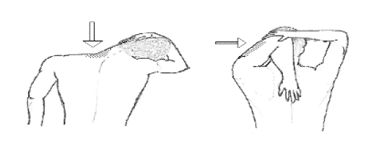Resources - Articles
A SERIES OF ESSAYS ON
NATUROPATHIC MEDICINE.
BY SHANNON O'HARA, RMT
PHYSICAL THERAPIES INFORMATION
Remedial Exercise as
Self-Care
The client who is motivated to perform a self-care program becomes an active participant in their own health and recovery.
There are natural processes in our bodies that tend to make muscles and connective tissue shorter and less flexible with time. A common way that people injure themselves is to play some sport, perhaps even just a game with their kids, after years of progressively lost flexibility. They then strain some muscles or ligaments that have become weak and stiff from disuse, and may experience pain and dysfunction for weeks, months and perhaps even years. Maintaining or regaining flexibility, particularly in the lower back area, is a very sensible investment of your time and effort.
Muscles, tendons, ligaments, fascia and skin are all soft tissues. Muscle fiber is contractile tissue which means that it has the ability to contract and relax. Tendons, ligaments, etc. are non contractile tissues. Shortened muscle fibers and connective tissues result in tight muscles. This is usually due to muscular inactivity and results in a decreased range of motion. A tight, shortened muscle becomes weaker as it is no longer able to develop peak tension. The muscle can be moderately lengthened by activities of daily living but not to its full range without performing a regular stretching regimen.
When done properly, stretching can do more than just increase flexibility. Benefits of stretching may include:
-
enhanced physical fitness
-
enhanced ability to learn and perform skilled movements
-
increased mental and physical relaxation
-
enhanced development of body awareness
-
reduced risk of injury to joints, muscles, and tendons
-
reduced muscular soreness
-
reduced muscular tension
-
increased suppleness due to stimulation of the production of chemicals which lubricate connective tissues
-
reduced severity of painful menstruation (dysmenorrheal) in females
Stretching exercises should be done once the muscle is warmed up, either through a hydrotherapy application (i.e.: heating pad, or under a hot shower), or by doing gentle range of motion exercises first. The general warm-up should begin with joint-rotations, starting either from your toes and working your way up, or from your fingers and working your way down. This facilitates joint motion by lubricating the entire joint with synovial fluid. Such lubrication permits your joints to function more easily when called upon to participate in your athletic activity. You should perform slow circular movements, both clockwise and counter-clockwise, until the joint seems to move smoothly.
Stretches should be slow and gentle, with no bouncing or ballistic movements. You should experience a feeling of pulling, but the stretch itself should be pain free. Moving into the stretch slowly, hold for 20-30 seconds. Once the feeling of tension is decreased, move into the stretch a little more. After this, gradually release the stretch. This should be done 5- 10 times, 2-3 daily if possible.
Ideally, a particular stretch should work only the muscles you are trying to stretch. Isolating the muscles worked by a given stretch means that you do not have to worry about having to overcome the resistance offered by more than one group of muscles. In general, the fewer muscles you try to stretch at once, the better. For example, you are better off trying to stretch one hamstring at a time than both hamstrings at once. By isolating the muscle you are stretching, you experience resistance from fewer muscle groups, which gives you greater control over the stretch and allows you to more easily change its intensity. Proper breathing control is important for a successful stretch. Proper breathing helps to relax the body, increases blood flow throughout the body, and helps to mechanically remove lactic acid and other by-products of exercise.
You should be taking slow, relaxed breaths when you stretch, trying to exhale as the muscle is stretching. Some even recommend increasing the intensity of the stretch only while exhaling, holding the stretch in its current position at all other times.
The proper way to breathe is to inhale slowly through the nose, expanding the abdomen (not the chest); hold the breath a moment; then exhale slowly through the nose or mouth. Inhaling through the nose has several purposes including cleaning the air and insuring proper temperature and humidity for oxygen transfer into the lungs. The breath should be natural and the diaphragm and abdomen should remain soft. There should be no force of the breath.
As a general rule, you should usually do the following when putting together a stretching routine:
- stretch your back (upper and lower) first
-
stretch your sides after stretching your back
-
stretch your buttocks before stretching your groin or your hamstrings
-
stretch your calves before stretching your hamstrings
-
stretch your shins before stretching your quadriceps (if you do shin stretches)
-
stretch your arms before stretching your chest
Stretching is a very important part of the treatment plan you'll have with your therapist. In general, you as the client will recover more rapidly and completely from a condition or injury when you participate actively in the healing process through a self care plan - which may include remedial exercises such as stretching or strengthening, hydrotherapy, self massage, diaphragmatic breathing.

Legal |
Privacy Policy |
Site Map copyright © 2004 Holistic Healing Arts